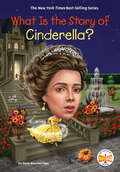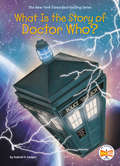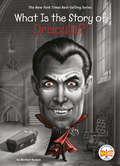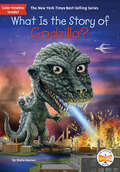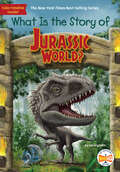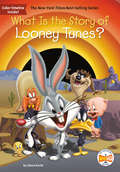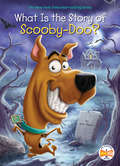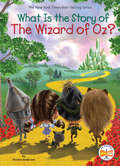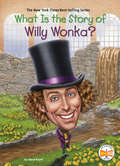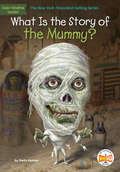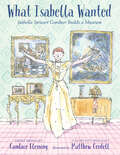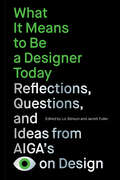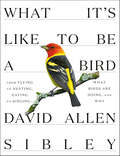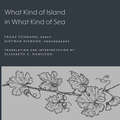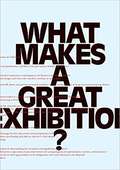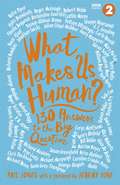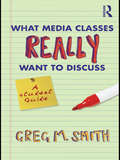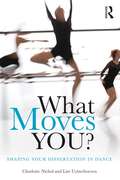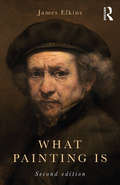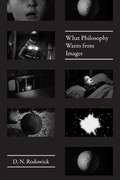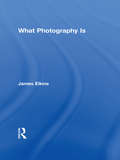- Table View
- List View
What Is the Story of Cinderella? (What Is the Story Of?)
by Who HQ Dana Meachen RauHow did the story of Cinderella, her glass slipper, the pumpkin carriage, and a magical night at the ball with a prince come to be? Find out in this dazzling book that explores the many different versions of Cinderella's story across different authors, movies, cultures, and more!Who HQ brings you the stories behind the most well-known characters of our time in the What Is the Story Of? series!Did you know that the first version of Cinderella's story was written two thousand years ago in Greece? It was about a young woman named Rhodopis and her missing sandal. Since then, many versions of this fairy tale have been written featuring a poor girl whose kindness led to her dreams coming true. China, Italy, France, and Germany all have distinct versions of Cinderella's story that author Dana Rau explains within this exciting nonfiction book for fans of the beloved princess. Young readers will learn over a dozen different versions of Cinderella's story, including the most famous versions by Charles Perrault, the Brothers Grimm, Walt Disney, and Rodgers and Hammerstein. Fans will also get to know the many different actresses who have brought Cinderella to life, including Brandy Norwood, Julie Andrews, Drew Barrymore, and Anne Hathaway.
What Is the Story of Doctor Who? (What Is the Story Of?)
by Who HQ Gabriel P. CooperWho HQ brings you the stories behind the most beloved characters of our time.This What Is the Story of? title is out of this universe! Learn the history of the Time Lord, the TARDIS, and the epic battles they've faced across time and space.When Doctor Who began airing on the BBC in 1963, British audiences were introduced to the rogue Time Lord from the planet Gallifrey. Now, viewers from all over the world are glued to their screens for the mysterious Doctor's intergalactic adventures. But how did this time traveler became such a beloved character? Author Gabriel P. Cooper provides readers with the inside scoop on the Doctor's unique time machine, loyal companions, and diabolical foes. This book, just like the show, is sure to intrigue a new generation of fans.
What Is the Story of Dracula? (What Is the Story Of?)
by Michael Burgan Who HqWho HQ brings you the stories behind the most beloved--and frightening!--characters of our time. Find out how Dracula--a smooth-talking count with a dark secret--became the infamous creature we all know and fear. From appearances in films and animated features to interpretations as a Muppet and breakfast cereal mascot, Dracula has been the inspiration for many other fictional vampires and is now an established figure in pop culture. Created by Bram Stoker in his 1897 Gothic horror novel, Count Dracula is a nobleman who uses his powers as a vampire to dominate his victims. Even though Dracula didn't succeed in the novel, the fictional character has lived on to dominate the real world as one of its most popular supernatural villains. Author Michael Burgan explores Dracula's mysterious origins in the historical figures who might have shaped the character, as well as the films and actors that cemented Dracula's place in cinematic history.
What Is the Story of Godzilla? (What Is the Story Of?)
by Sheila Keenan Who HQWho HQ brings you the stories behind the most well-known characters of our time. In this addition to the What Is the Story Of? series, young readers will discover the exciting story of one of the world's favorite monsters...Godzilla!In 1954, Godzilla appeared on screen for the first time in a Japanese film directed by Ishirō Honda. Awakened by nuclear radiation, the enormous sea monster has appeared in over thirty other films, making Godzilla the longest-running film franchise in history. Known as the "King of the Monsters," Godzilla has earned a huge fanbase worldwide. The dinosaur-like amphibian has been featured alongside friends and foes such as Mothra and Mechagodzilla, in TV shows, books, video games, and more. There is even a Godzilla star on the Hollywood Walk of Fame! Learn about the lasting legacy of this iconic character in this nonfiction book for young readers.
What Is the Story of Jurassic World? (What Is the Story Of?)
by Jim Gigliotti Who HQPrepare to be thrilled by an imaginary world where dinosaurs have been brought back to life and roam alongside humans in this Who HQ book all about Jurassic World!Discover the action-packed history of Jurassic World and how dinosaur fans of all ages came to love the series' movies, books, TV shows, and even theme park rides. From the 1990 Michael Crichton novel to the movies still releasing today, young readers will love stepping into this world where dinosaurs rule. The Jurassic World franchise has thrilled fans for decades by building a world where science and adventure meet, raising the question: Could dinosaurs and humans ever really live together?
What Is the Story of Looney Tunes? (What Is the Story Of?)
by Steve Korte Who HQWho HQ brings you the stories behind the most beloved characters of our time.If you're a fan of Acme anvils and know that the question "What's up, Doc?" needs no answer, this history of the cartoon favorites Looney Tunes is for you!In the 1930s, Warner Brothers studios introduced the world to the Looney Tunes. A witty rabbit named Bugs, a stuttering pig named Porky, and an erratic duck named Daffy are just some of the characters that have left audiences hysterically laughing for almost a century. These animated short films, starring some of the most iconic cartoon characters in history, went on to have a second, long life on television.In this book, author Steve Korte details how these toons were imagined, which talented folks were tasked with animating and voicing them, the success the shows and films have garnered over the years, and what lies ahead for Bugs and the gang.
What Is the Story of Scooby-Doo? (What Is the Story Of?)
by Who HQ M. D. PayneYour favorite characters are now part of the Who HQ library! Nothing mysterious about it! Learn all about how Scooby and his friends took over Saturday mornings--and then the world--in this debut title in the What Is the Story Of? series.Most kids are familiar with the always-hungry, scaredy-cat Great Dane called Scooby-Doo and his true-blue friends of Mystery Inc. But how did Scooby and the gang make it onto the silver screen? Author M. D. Payne lays out the whole groovy tale in this book that's sure to have readers shouting, "Zoinks!"
What Is the Story of The Wizard of Oz? (What Is the Story Of?)
by Kirsten Anderson Who HQWho HQ brings you the stories behind the most beloved characters of our time.We're off to see the Wizard...along with Dorothy, Toto, and all of her friends as they make their way onto the What Is the Story of? list. When L. Frank Baum wrote about the adventures of a young farm girl named Dorothy and her pet dog in the magical Land of Oz in 1900, he wanted to create a beautiful story based on the America he knew and treasured. But he had no idea his book would become a bestseller and grow into the cultural phenomenon that it is today. After the iconic 1939 film, numerous sequels, retellings, and musicals, it's easy to see why The Wizard of Oz has been called "America's greatest and best-loved homegrown fairytale." From Baum's first book through Wicked, the story of The Wizard of Oz is as fascinating as the tale itself.
What Is the Story of Willy Wonka? (What Is the Story Of?)
by Steve Korte Who HQ#1 New York Times bestselling Who HQ series brings you the stories behind the most beloved characters of our time.Grab your golden ticket and learn how Willy Wonka became an internationally popular figure in literature and film.The whimsical, wacky, and wondrous character of Willy Wonka made his first appearance in Roald Dahl's 1964 children's novel Charlie and the Chocolate Factory. When the fictional factory owner opened up the doors of his company, readers were welcomed into his world of pure imagination...and chocolate! Wonka went on to dazzle a whole new set of fans in the 1971 film that brought Dahl's characters to life. Since then, there have been other movie adaptations, books, musicals, and even theme park rides that bring the world just a little bit closer to this fantastic chocolatier. Learn about the legacy of Wonka in this new book from the #1 New York Times bestselling series.
What Is the Story of the Mummy? (What Is the Story Of?)
by Sheila Keenan Who HQYour favorite characters are now part of the Who HQ library!The Mummy joins other classic horror characters Dracula and Frankenstein in our What Is the Story Of? series.Unlike the other classic Universal horror movie monsters of their time, the Mummy's origins can't be found in the pages of a book. His story was inspired by the opening of King Tut's tomb in 1922. The world fell in love with all things Egyptian and was enthralled with stories of ancient mummies. The film producers of the early Dracula and Frankenstein films wasted no time creating a character who's been creeping out of his coffin and entertaining audiences since 1932. Author Sheila Keenan explains the history of the movie and its remakes, the legendary curse of King Tut's mummy, and what lies ahead for this monstrous creature.
What Isabella Wanted: Isabella Stewart Gardner Builds a Museum
by Candace FlemingFrom multiple award-winning author Candace Fleming and Caldecott Medalist Matthew Cordell comes the true story of a woman who always got what she wanted: Isabella Stewart Gardner.A New England Book Award FinalistFor years, the indomitable Isabella Stewart Gardner searched the world for magnificent artwork and filled her home with a truly unique collection, with the aim of turning it into a museum, which she established in 1903.Isabella always did things her own way. One day she'd wear baseball gear to the symphony, the next, she'd be seen strolling down the street with zoo lions. It was no surprised that she was very particular about how she arranged her exhibits. They were not organized historically, stylistically, or by artist. Instead, they were arranged based on the connections Isabella felt toward the art, a connection she hoped to encourage in her visitors.For years, her museum delighted generations of Bostonians and visitors with the collections arranged exactly as she wanted. But in 1990, a spectacular burglary occurred when two thieves disguised as police officers stole thirteen paintings, valued at $500 million, including a Rembrandt and a Vermeer. They have yet to be recovered, though a $10 million reward is still being offered for their safe return.Author Candace Fleming perfectly captures Isabella's inimitable personality and drive, accompanied by exuberant illustrations by Matthew Cordell.A Junior Library Guild Gold Standard SelectionA CCBC Choice
What It Means to Be a Designer Today: Reflections, Questions, and Ideas from AIGA’s Eye on Design
by Liz Stinson and Jarrett FullerAIGA’s Eye on Design presents a provocative collection of essays and interviews that cover a wide-reaching examination of the profession of design today and its impacts on society and culture.Eye on Design is an editorial platform from AIGA that has, for the last decade, covered the ins and outs of the design industry. From documenting bold new work from global designers to chronicling the field's most critical issues, their reported stories, op-eds, interviews, and conversations help designers make sense of the world and place their profession within a broader context. Weaving together original and previously published content from some of the most important writers in today’s design conversation, this book for designers encapsulates wide-reaching topics that strive to answer an essential question: What does it mean to be a designer today?Organized into three parts—Reflections, Questions, and Ideas—this book covers the most pressing issues and provocations that designers face in our current world, including:The evolution of personal brandingTeaching design historyThe cult of minimalismThe perils of hero worshipDesigners’ role in conspicuous consumptionThe meaning of visual sustainabilityAnd moreContributors include the book's editors, Liz Stinson and Jarrett Fuller, and such outstanding design writers as Rick Poynor, Anne Quito, Briar Levit, Cliff Kuang, and many more. Accessible, engaging, and conversational, What It Means to Be a Designer Today is an enduring resource and vibrant gift book that speaks to design students and educators, working designers of all levels, and anyone interested in graphic design.
What It's Like to Be a Bird: From Flying to Nesting, Eating to Singing--What Birds Are Doing, and Why (Sibley Guides)
by David Allen SibleyThe bird book for birders and nonbirders alike that will excite and inspire by providing a new and deeper understanding of what common, mostly backyard, birds are doing--and why"Can birds smell?" "Is this the same cardinal that was at my feeder last year?" "Do robins 'hear' worms?" In What It's Like to Be a Bird, David Sibley answers the most frequently asked questions about the birds we see most often. This special, large-format volume is geared as much to nonbirders as it is to the out-and-out obsessed, covering more than two hundred species and including more than 330 new illustrations by the author. While its focus is on familiar backyard birds--blue jays, nuthatches, chickadees--it also examines certain species that can be fairly easily observed, such as the seashore-dwelling Atlantic puffin. David Sibley's exacting artwork and wide-ranging expertise bring observed behaviors vividly to life. (For most species, the primary illustration is reproduced life-sized.) And while the text is aimed at adults--including fascinating new scientific research on the myriad ways birds have adapted to environmental changes--it is nontechnical, making it the perfect occasion for parents and grandparents to share their love of birds with young children, who will delight in the big, full-color illustrations of birds in action. Unlike any other book he has written, What It's Like to Be a Bird is poised to bring a whole new audience to David Sibley's world of birds.
What Kind of Island in What Kind of Sea?
by Franz FühmannThe dignity of cognitively disabled people and the ethics of representing their lives are at the heart of an extraordinary yet little-known book first published in the former German Democratic Republic. Was für eine Insel in was für einem Meer, or What Kind of Island in What Kind of Sea (Rostock, Hinstorff, 1986) depicts residents of a church-run institution for people with cognitive disabilities in astonishing black-and-white photographs by Dietmar Riemann and in a probing, poignant essay by esteemed German writer Franz Fühmann. This important text, which moved from a medical model to a historical and cultural view of disability as an aspect of human identity and experience, is translated into English for the first time by Elizabeth Hamilton and includes reflections on the book and its impact. As fuller, global histories of disability are now being written, What Kind of Island in What Kind of Sea opens an essential window onto a formerly shuttered world, demonstrating the power of the arts to hone our capacity to perceive and appreciate human difference.
What Makes A Great Exhibition?
by Paula MarincolaRising attendance at museums, along with increased press coverage in the age of the international biennial and the ‘blockbuster’ exhibition, has translated into a growing interest in how exhibitions are made. The new curatorial studies programmes springing up across Europe and North America often deal with theoretical issues, yet one of the central questions of curating frequently remains unframed: What makes an exhibition great? In this book, fourteen essays by active curators and historians address the issue head-on. Focusing on the curation of contemporary art in North America and Europe, What Makes a Great Exhibition? includes essays by the prolific curator Robert Storr on the meaning of ‘exhibition’ and ‘exhibition-maker’; Studio Museum in Harlem director Thelma Golden writes on ethnically specific exhibitions; Dia Foundation curator Lynne Cooke shows how to firmly ground rarified aims; Iwona Blazwick details a century of trailblazing at London’s Whitechapel Art Gallery, where she is director; and curator Carlos Basualdo reflects on the need to establish a meaningful critical context for international biennials. Other writers address such issues as the labelling of exhibits, group exhibitions, exhibiting design, video and craft, as well as the way a venue’s architecture can influence the exhibitions it houses. What Makes a Great Exhibition? contains carefully considered answers to numerous questions of practice even as it raises more questions about exhibition-making today. Stimulating thought about how curatorial objectives mesh with on-the-ground practicalities, this book is vital reading for arts professionals, students of art and curatorial studies, art historians, practising artists and anyone curious about exhibition-making today.
What Makes Us Human?: 130 answers to the big question
by Phil Jones Jeremy VineA dazzling insight into what gives meaning to our life and to us as a species.What makes us human? From Carlo Rovelli on the particles of dust that make us, to Caitlin Moran on the joy of Friday nights, and A C Grayling on how we express ourselves through culture: this illuminating book shares 130 mind-expanding answers to that question.We all want to understand our place in the universe and find a sense of purpose in the life. This book will help the reader navigate that journey with the help of leading names from the worlds of literature, history, philosophy, politics, sport, comedy and popular culture. Originally broadcast as a popular feature on the Jeremy Vine Show, What Makes Us Human? includes short essays from: Andrew Marr, Carlo Rovelli, Marian Keyes, Alain de Botton, Robert Webb, Richard Dawkins, Stephen Fry, and many more.
What Makes Us Human?: 130 answers to the big question
by Phil Jones Jeremy VineA dazzling insight into what gives meaning to our life and to us as a species.What makes us human? From Carlo Rovelli on the particles of dust that make us, to Caitlin Moran on the joy of Friday nights, and A C Grayling on how we express ourselves through culture: this illuminating book shares 130 mind-expanding answers to that question.We all want to understand our place in the universe and find a sense of purpose in the life. This book will help the reader navigate that journey with the help of leading names from the worlds of literature, history, philosophy, politics, sport, comedy and popular culture. Originally broadcast as a popular feature on the Jeremy Vine Show, What Makes Us Human? includes short essays from: Andrew Marr, Carlo Rovelli, Marian Keyes, Alain de Botton, Robert Webb, Richard Dawkins, Stephen Fry, and many more.
What Makes a Great City
by Alexander GarvinWhat makes a great city? City planner and architect Alexander Garvin set out to answer this question by observing cities, largely in North America and Europe, with special attention to Paris, London, New York, and Vienna.For Garvin, greatness is about what people who shape cities candotomakea city great. A great city is a dynamic, constantly changing place that residents and their leaders can reshape to satisfy their demands. Most importantly, it is about the interplay between people and public realm, and how they have interacted throughout history to create great cities.What Makes a Great Citywill help readers understand that any city can be changed for the better and inspire entrepreneurs, public officials, and city residents to do it themselves.
What Media Classes Really Want to Discuss: A Student Guide
by Greg SmithYou probably already have a clear idea of what a "discussion guide for students" is: a series of not-very-interesting questions at the end of a textbook chapter. Instead of triggering thought-provoking class discussion, all too often these guides are time-consuming and ineffective. This is not that kind of discussion guide. What Media Classes Really Want To Discuss focuses on topics that introductory textbooks generally ignore, although they are prominent in students’ minds. Using approachable prose, this book will give students a more precise critical language to discuss “common sense” phenomena about media. The book acknowledges that students begin introductory film and television courses thinking they already know a great deal about the subject. What Media Classes Really Want To Discuss provides students with a solid starting point for discussing their assumptions critically and encourages the reader to argue with the book, furthering the 'discussion' on media in everyday life and in the classroom.
What Moves You?: Shaping your dissertation in dance
by Charlotte Nichol Lise UytterhoevenEvery dissertation is individual and unique - particularly for dance students, who must combine a wide range of approaches into a tailor-made research methodology. What Moves You? fosters a creative approach to dissertations and final projects. By guiding the development of a personal study program, this volume encourages dance students to take ownership of their artistic and academic work, a skill essential both to successful undergraduate study, and to making the first steps towards a career in dance. Rather than propose a prescriptive, step-by-step mantra, Charlotte Nichol and Lise Uytterhoeven draw upon contributions from students, teachers, examiners and practitioners to broaden the notion of ‘research’ and demystify the purpose of the dissertation.
What Music Schools Learned from the Pandemic: The 2020 Revision (Routledge Studies in Music Education)
by Robert CutiettaThe pandemic and social unrest during the year of 2020 set in motion sudden and drastic changes to how collegiate music was taught. Teachers and students experienced the most dramatic disruption in the history of the music teaching profession.This book examines the state of collegiate music teaching prior to 2020 and then captures these radical and sudden changes through the eyes of music conservatory leaders from around the world. These leaders, who had a comprehensive view of what was unfolding, described what happened during this once-in-a-century event.From their insights, we see what worked and what didn’t. The book then examines what this experience means, or could mean, for the future of music in higher education.
What Painting Is: How to Think about Oil Painting Using the Language of Alchemy
by James ElkinsIn this classic text, James Elkins communicates the experience of painting beyond the traditional vocabulary of art history. Alchemy provides a strange language to explore what it is a painter really does in the studio—the smells, the mess, the struggle to control the uncontrollable, the special knowledge only painters hold of how colors will mix, and how they will look. Written from the perspective of a painter-turned-art historian, this anniversary edition includes a new introduction and preface by Elkins in which he further reflects on the experience of painting and its role in the study of art today.
What Philosophy Wants from Images
by D. N. RodowickIn recent decades, contemporary art has displayed an ever increasing and complicated fascination with the cinema—or, perhaps more accurately, as D. N. Rodowick shows, a certain memory of cinema. Contemporary works of film, video, and moving image installation mine a vast and virtual archive of cultural experience through elliptical and discontinuous fragments of remembered images, even as the lived experience of film and photography recedes into the past, supplanted by the digital. Rodowick here explores work by artists such as Ken Jacobs, Ernie Gehr, Victor Burgin, Harun Farocki, and others—artists who are creating forms that express a new historical consciousness of images. These forms acknowledge a complex relationship to the disappearing past even as they point toward new media that will challenge viewers’ confidence in what the images they see are or are becoming. What philosophy wants from images, Rodowick shows, is to renew itself conceptually through deep engagement with new forms of aesthetic experience.
What Photography Is
by James ElkinsIn What Photography Is, James Elkins examines the strange and alluring power of photography in the same provocative and evocative manner as he explored oil painting in his best-selling What Painting Is. In the course of an extended imaginary dialogue with Roland Barthes's Camera Lucida, Elkins argues that photography is also about meaninglessness--its apparently endless capacity to show us things that we do not want or need to see--and also about pain, because extremely powerful images can sear permanently into our consciousness. Extensively illustrated with a surprising range of images, the book demonstrates that what makes photography uniquely powerful is its ability to express the difficulty--physical, psychological, emotional, and aesthetic--of the act of seeing.
What Remains: The Suitcases of Charles F. at Willard State Hospital (Excelsior Editions)
by Ilan Stavans Jon CrispinAfter the closure of Willard Psychiatric Center on New York's Seneca Lake in 1995, more than four hundred abandoned suitcases were discovered in its attic, containing thousands of personal possessions belonging to former patients. Three of the suitcases were owned by Charles F., an eighty-four-year-old Russian Jewish immigrant arrested at a Brooklyn subway station in 1946 and institutionalized at Willard State Hospital (as it was then known).An extraordinary collaboration between image and text, What Remains pairs Jon Crispin's gripping photographs of Charles's belongings with Ilan Stavans's intriguing, speculative portrait of a patient and institution at odds with one another. Anxious, isolated, and senile, Charles strikes an unexpected friendship with a young doctor whose empathy accompanies him through a sudden spiritual awakening. As the narrative unfolds, it becomes clear that Stavans, himself an immigrant from Mexico whose family history is marked by bouts of mental illness, approaches his character as a surrogate of his own personal journey. Crispin's photographs of Charles's possessions—including clothing, household tools, and Jewish ritual objects—are haunting in their ability to compel the reader to imagine a distant man's life. A moving blend of fact and fiction, photography and prose, What Remains reflects on questions of mental health, spirituality, and the Jewish immigrant experience in midcentury America.
